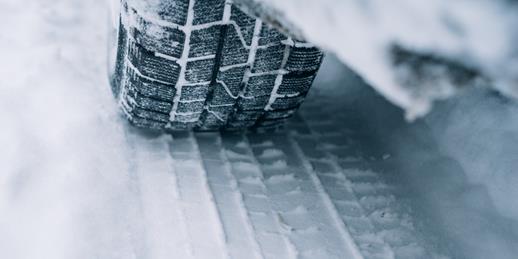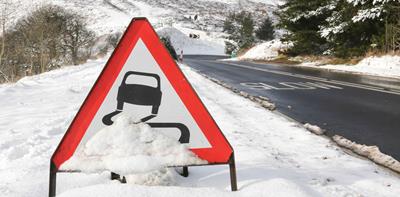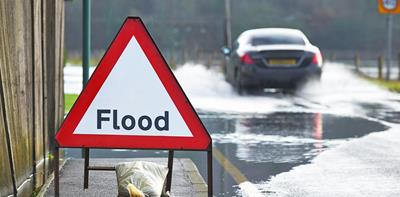
For even the most experienced motorists, extra care is needed when driving in winter. Whether you're facing a white-knuckle drive through snow and ice or being buffeted by blizzards, there are plenty of challenges.
If you’re driving in snow for the first time, follow these helpful tips to help you stay safe on the roads this winter.
Easy As Hack
Keep a bag of non-clumping cat litter in your boot (yes really!). If your car gets stuck in snow, you can sprinkle a few handfuls around your tyres to give your wheels some traction.
At a glance
- Stopping distances can be 10 times longer in icy conditions
- A winter car kit is a must in case of delays and breakdowns
- Black ice can lurk under bridges, trees and in dips in the road
1. Allow extra time for your journey
Keep up to date with the weather forecast so you’re prepared for what’s to come. If it's below freezing, allow time to de-ice your car windows before you set off. If you can’t see where you’re going, you’re putting yourself and others in danger.
Icy, foggy and stormy conditions mean the same distance can take longer. So if your morning commute normally takes half an hour, allow more time to get to your workplace and save getting stressed on the road.
2. Carry a winter car care kit
When you’re preparing for winter, it’s helpful to put together a winter car kit in case you get stuck in snow or your car breaks down. It should include:
- A fully charged mobile phone
- Ice-scraper
- De-icing spray
- Fold-up shovel
- Warm clothes
- Sturdy walking boots or shoes
- Blanket or travel rug
- A torch
- Reflective jacket
- Water and an emergency snack
3. Keep your distance from other cars
Slowing your speed and increasing your braking distance will greatly reduce your risk of being involved in an accident when driving on ice and snow.
In normal dry conditions, leaving a two-second gap between cars is enough to brake safely. But in icy conditions, stopping distances can be 10 times longer , so make sure you allow enough time and space to stop on slippery roads if you need to.
Don’t miss: How to stay safe driving in the dark
4. Turn into a skid if you start to slide
Losing control of your vehicle can be very scary, but do your best to stay calm. If you begin to slide on snow or ice, the general rule is to steer into the skid. While your natural instinct might be to slam on the brakes as hard as you can, this can make matters worse.
Take your foot off the brake and turn your steering wheel in the direction that your vehicle is skidding towards. This can help straighten your car safely back into place on the road.
5. Park your car facing east
When you're parking in icy or snowy weather, ideally park with the car windscreen facing east. The sun might be weak at this time of year, but it can still speed up the process of defrosting your windscreen. You'd be surprised how many accidents are caused by not de-icing properly.
Also try to park facing downhill or on a level surface as driving off on an uphill slope is likely to prove risky; you could lose traction and roll backwards into another car.
6. Keep your car winter-ready
When driving in winter, it’s especially important that your car is in good condition and well maintained. You definitely don’t want to end up stranded by the roadside in the freezing cold. If you’re driving in snow for the first time, make sure your:
- Car lights are all working and visible
- Tyres are pumped to the correct pressure
- Number plates are clean and clearly visible
- Windscreen wipers and screenwash are working
Also remember to clean any snow off your car roof as this can impair your visibility if it drops down onto your windscreen. It can be a danger to other drivers if chunks of snow fly off while you’re driving.
Read this: 10 tips to prepare your car for the cold weather
7. Drive smoothly and carefully
Icy conditions can be very dangerous and make you feel as if nerves of steel are required just to drive to the supermarket. If you do need to drive in ice or snow, stick to gritted roads as much as possible.
Keep your speed down when driving in ice or snow. Let your braking, acceleration and steering be gentle and unhurried. Fresh snow offers more grip than ice so try not to follow the tyre marks of the vehicle in front of you on the road.
8. Watch out for black ice
Because black ice is virtually invisible, it makes it all the more hazardous. When the day has warmed up and much of the ice seems to have melted, it's easy to get caught out.
When driving in winter, always be aware that there can still be ice in places that the sun hasn't been able to reach yet such as under bridges, under the shadow of trees or where there are dips in the road.
9. Avoid unnecessary journeys
Last but not least, if you feel uneasy about driving on ice and snow, ask yourself whether you really need to go out. It might be safer to put off your trip than risk getting into difficulty.
If the weather is treacherous, it’s always advised to avoid any unnecessary journeys.
Original article written 24th September 2021, updated 27th October 2023
Protect your vehicle against winter mishaps
Ageas car insurance is Defaqto 5 Star rated, with optional breakdown cover powered by RAC to keep you safe out on icy roads.


